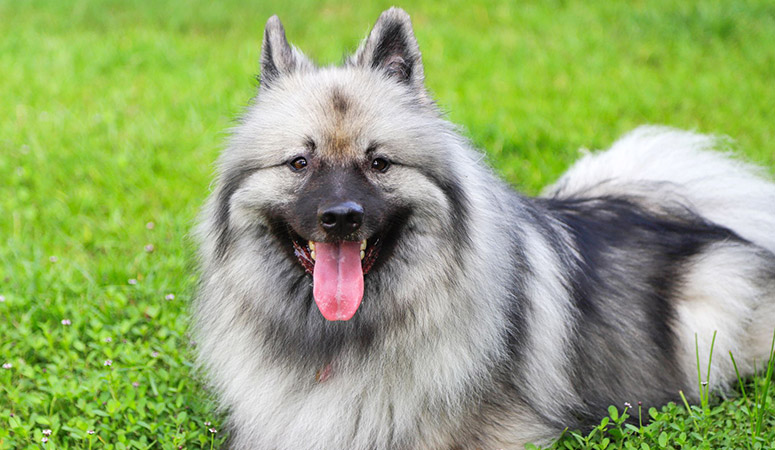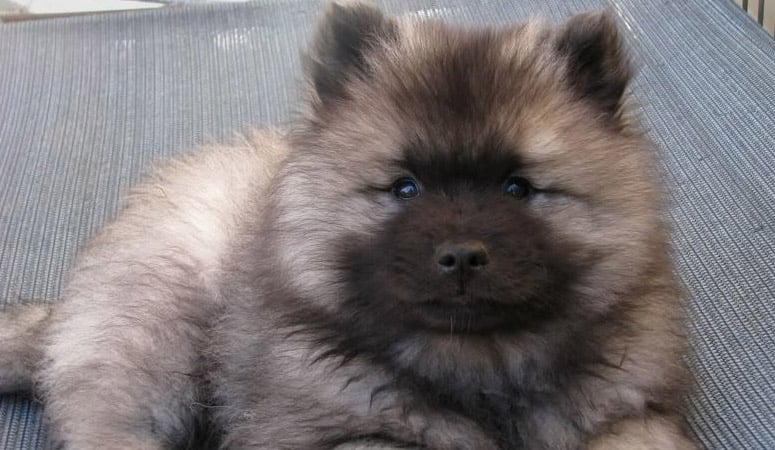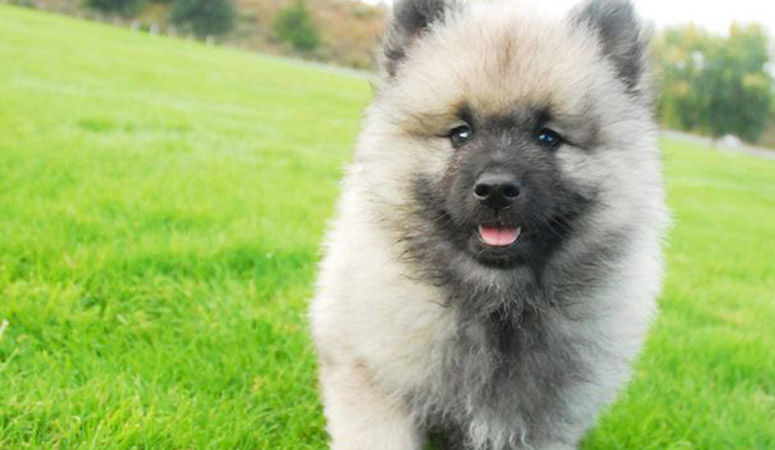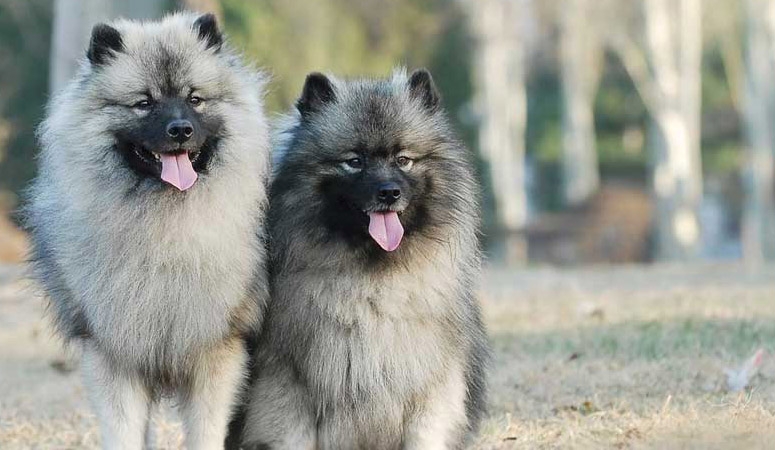Keeshond
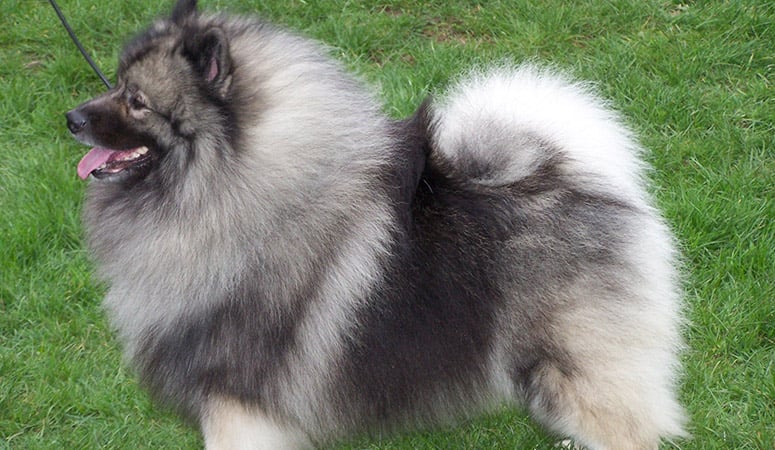
The Keeshond is a medium-sized dog with small erect ears and round black eyes, famous for the unique “spectacles” on his foxy face. They are originated in the 16th century Holland, and they were used as a guard dog for riverboats. Today, the Keeshonds are popular family dogs.
| Other Names | German Wolfspitz, Kees, Keeshond, Wolfspitz, Wolfsspitz |
| Color | Gray, black, and cream |
| Height | Males: 18-20 inches. Females: 17-19 inches. |
| Weight | Males: 55-66 pounds. Females: 55-66 pounds. |
| Life Span | 12-15 years |
| Personality | Friendly, Lively, Outgoing |
| Exercise | Regular Exercise |
| Origin |
| Popularity | #88 |
| Groom Needs | 2-3 Times a Week |
| Kids Friendly | Yes |
| Dog Friendly | Yes with supervision |
| Watch Dog | |
| Family Dog | Yes |
| Litter Size | 3-8 |
Keeshond Pictures
Keeshond Video
Introduction
The Keeshond is a medium-sized dog with a double coat, a ruff, and a full shaggy tail. They give the appearance of a wolf in dog clothing. Their black, grey, and white coats were specified long ago, in the standard of 1901. They are alternatively called the Dutch Barge Dogs, as they were seen on barges that regularly crossed the rivers in the Netherlands. Their double coat consists of straight, long, and harsh topcoats and the thick undercoat.
Keeshonden are wonderful family dogs. They do well in obedience and agility trainings and are regarded as good children companions. Being a medium-sized dog, a full-grown male Keeshond stands 18-19 inches at the shoulder, being a little taller than a similar female, which is likely to weigh around 17-18 inches. Keeshonden weigh in the range of 30-45 pounds and have an average lifespan of 12-15 years.
Living with Keeshond
Unexpectedly, the Keeshond’s full coat is relatively easy to maintain. Going through the dog’s coat once a week with a pin brush is usually enough. This is helpful to keep the undercoat brushed out and keep shedding to a minimum. The Keeshond does shed massively twice a year in spring and fall, when he “blows” or sheds his entire undercoat all at once. This shedding period would last for three weeks.
Keeshonds are relatively clean dogs, with little doggie odor. So bathing is only when necessary about every three months. Check the dog’s ears every week for dirt, redness, or a bad odor that may indicate an infection. Brush the teeth at least two or three times a week to keep fresh breath and prevent gum disease. And trim the nails every month to prevent cracking.
Keeshond doesn’t need much exercise daily, a moderate walk or jog every day are enough to meet the dog’s exercise need. And taking a Keeshond to a dog park is a good option where he can do well in. Besides, games and tricks could provide needed mental exercise. Without appropriate exercise, they can become unruly and rip things apart inside of the house. A free run or a nice walk daily is good for their physical and mental health, and then your dog would be glad to stay with you on the sofa while you read or watch TV.
The owner needs to know that the Keeshond is not fond of hot climates, it is better to keep your dog in an air-conditioned house or near fans in the hot days.
Generally, it is recommended to feed a Keeshond with one to two cups of high-quality dry dog food every day, divided into two meals. More importantly, the food amount should depend on the dog’s weight, size, age, and activity level. There should be fresh and clean water at all times.
Some dogs are easy to get overweight, so you need to watch their calorie consumption and weight level all the time. Treats may be an important aid in training, but excessive intake can lead to obesity. Also, owners need to distinguish which human food is safe for dogs and which are not. If you have any problems with your dog’s weight or diet, just consult from your veterinarian.
Keeshonds are prone to the following health conditions: hip dysplasia, Addison’s disease, progressive retinal atrophy, Von Willebrand’s disease, patellar luxation, hypothyroidism, epilepsy, cataracts, etc.
Major concerns: none
Minor concerns: epilepsy, CHD, patellar luxation, skin problems, elbow dysplasia
Occasionally seen: tetralogy of Fallot, renal cortical hypoplasia, mitral valve insufficiency
Suggested tests:
Elbow Evaluation
Hip Evaluation
Patella Evaluation
Ophthalmologist Evaluation
Total Annual Cost: $2765
Cost is estimated for the first year and may vary depending on many factors, such as dog food, health care, leash, collar, licensing, possible fencing, crates, training and obedience classes, dog-walking, grooming, treats, toys, flea, tick, and heart-worm meds, microchips, etc.
Keeshonds are very smart and highly trainable. They are good at obedience, where some of them are nationally ranked. Also, some of them have distinguished themselves in therapy work. They can learn things quickly and they are easy to be motivated to please their trainers. But the trainer has to keep up with them or they could become bored.
Besides, Keeshonds can learn basic commands with ease. It is ideal to use positive reinforcement, dog treats, and consistency to train this sensitive breed.
Keeshonden is agile and athletic, and when they participate in advanced obedience training, agility training and most dog sports, they will benefit physically and mentally.
History
The basic distinguishing factor amongst German Spitzes is the color and size guidelines. The Keeshond is thought to have descended from old German Spitzes, which were regarded as keeshond in Netherland. Although the history of the Keeshond breed is not totally understood, historians believe that the Keeshond (plural, Keeshonden) originated from the Netherlands. The FCI thinks different, linking this dog breed to the family of German Spitzes that originated in Germany, such as the Pomeranian and American Eskimo dog.
The Keeshond was named after Cornelis (Kees) de Gyselaer, Dutch Patriot who rebelled against the House of Orange. The dog was the symbol of the rebels at that time. The Keeshond has been a readily accepted breed in Netherland and Germany since the 1800s. The Wolf Spitzes had their breeding standard drafted, perhaps, in 1880. After the Club for German Spitzes was formed in 1899, the standard for their breeding was later revised at the turn of the 20th century, with a special specification of the color which is still known till date.
The British Kennel Club displayed a type of Keeshond called the Overweight Pomeranian (a German Spitz), in the 19th century. This Overweight Pomeranian, which seemed to be the standard then, lost its British recognition around the 1910s, and by 1920, Baroness van Hardenbroeck of Netherlands decided to breed and improve on the Keeshond breed. The first Keeshond Club in the Netherlands was later founded in 1924. Carl Hinderer is credited with the recognition of the breed by the British and American Kennel Clubs after World War II. Germany fell out of regard to England and America, which had led to the loss of recognition of the Wolf Spitz and Keeshond before Carl took up the case. This breed was first registered by the AKC in 1930.
Helpful Information
Breed Club: KEESHOND CLUB OF AMERICA, INC.
Breed Club Link: https://www.keeshond.org/
Breed Club Rescue:
Breed Club Rescue Link: https://www.keeshond.org/keeshond-rescue

